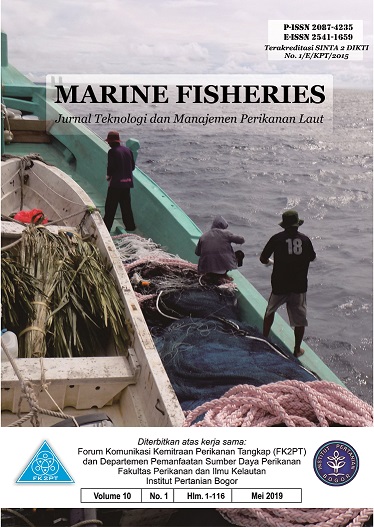DINAMIKA HASIL TANGKAPAN BARONANG (Siganus sp.) PADA RUMPON HIDUP SECARA SPASIAL-TEMPORAL DI PESISIR ULOULO KABUPATEN LUWU
Abstract
ABSTRACT
Biological-Fish Aggregation Devices (Bio FADs) is FADs which designed used seaweed as an attractor. Bio FADs in this study were made using two species of seaweed i.e Eucheuma cottonii, called cottonii FADs (FC) and Gracilaria sp. called gracilaria FADs (FG). The purpose of this study was to analyze the dynamics of Siganus sp catch around Bio FADs based on species, abundance, and ecological characteristics spatially and temporally. The research was conducted in Uloulo coastal waters of Luwu district from October 2014 to August 2015. Fish samples were collected by using scoop net on both types of FADs which were installed in three different habitats as observation stations. The Shannon-Wienner (H') diversity index is relatively moderate in spatially and temporally. ANOSIM shows that the abundance of fish catches between habitats is significantly different (R = 0,268; p = 0,001). River estuary habitat has the highest abundance of catches which is about 14.77 ind/m2. Furthermore, the abundance of catches between monsoon was significantly different (R = 0,110; p = 0,001). The highest abundance of fish catches in the west monsoon (WM) is about 20,67 ind/m2. SIMPER analysis shows that Siganus canaliculatus is the main species based on habitat and season. The contribution of Siganus canaliculatus is quite high in seagrass habitat which is about 96.38%. Keywords: Bio-FADs, dynamics of catch, Siganus sp.ABSTRAK
Rumpon hidup atau Biological-Fish Aggregation Devices adalah rumpon yang didesain menggunakan rumput laut sebagai atraktor. Rumpon hidup pada penelitian ini dibuat dengan menggunakan rumput laut jenis Eucheuma cottonii sehingga disebut rumpon cottonii(RC) dan Gracillaria sp atau rumpon gracillaria (RG). Tujuan penelitian ini adalah menganalisis dinamika hasil tangkapan ikan baronang (Siganus sp.) di sekitar rumpon hidup berdasarkan jenis, kelimpahan, dan karakteristik ekologis secara spasial dan temporal. Penelitian ini dilaksanakan di perairan pesisir Uloulo Kabupaten Luwu dari bulan Oktober 2014 sampai Agustus 2015. Sampel ikan dikumpulkan dengan menggunakan serok pada kedua jenis rumpon yang dipasang di tiga habitat yang berbeda sebagai stasiun pengamatan. Indeks diversitas Shannon-Wienner (H') secara spasial dan temporal relatif moderat. Hasil ANOSIM menunjukkan bahwa kelimpahan hasil tangkapan ikan antar habitat berbeda sangat nyata, (R = 0,268; p = 0,001). Habitat muara sungai memiliki kelimpahan hasil tangkapan tertinggi yaitu 14,77 ind/m2. Selanjutnya kelimpahan hasil tangkapan berdasarkan musim berbeda nyata (R = 0,110; p = 0,001). Kelimpahan hasil tangkapan ikan tertinggi pada musim barat (MB) yaitu 20,67 ind/m2 .Analisis SIMPER menunjukkan bahwa Siganus canaliculatus sebagai spesies utama berdasarkan habitat dan musim. Kontsribusi Siganus canaliculatus cukup tinggi pada habitat padang lamun yaitu sebesar 96,34% .
Kata kunci: rumpon hidup, dinamika hasil tangkapan, Siganus sp.Downloads
Author(s) who published in this journal agree to following terms:
- Author(s) must understand and agree that the copyright script in published owned by the Marine Fisheries Journal. The copyright includes reproducing and selling the manuscript to all parties.
- Everyone can cite every manuscript published in Marine Fisheries for educational purposes, with the author's name and the Marine Fisheries Journal on reference.









